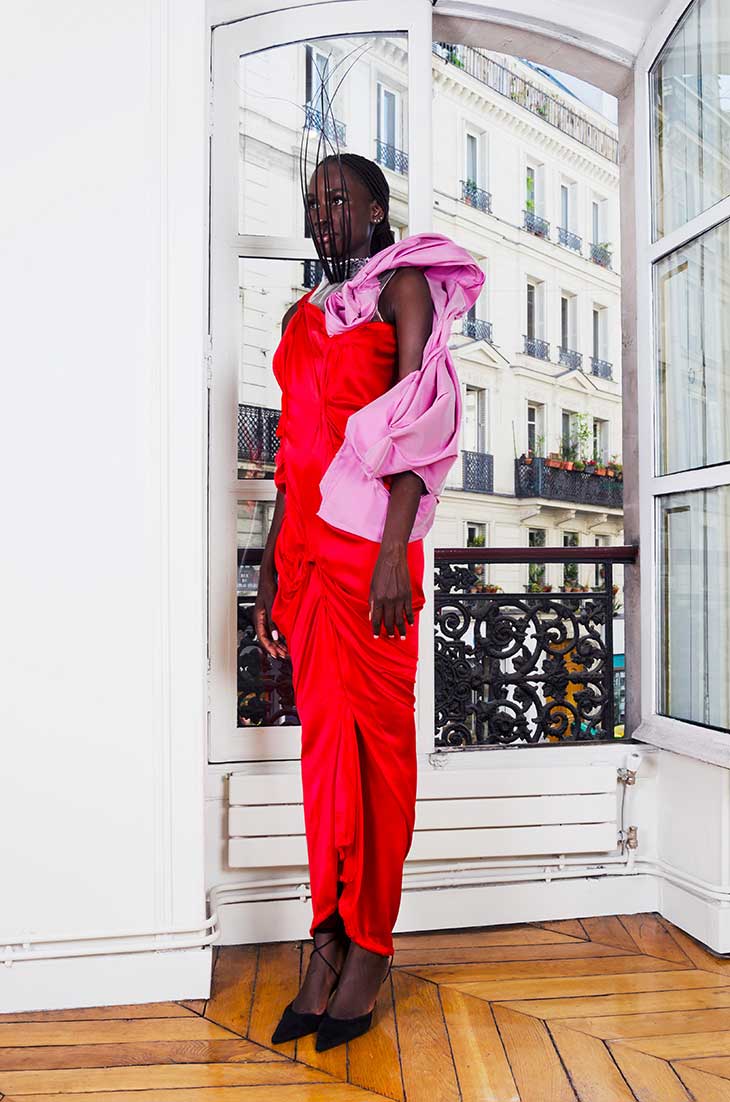
INTERVIEWS
Fair’s latest FW24 collection, presented at Chateau d’Eau in Paris, draws inspiration from Wassily Kandinsky’s abstract use of color and the untamed beauty of the African wilderness. Each piece showcases his expert draping techniques, from hand-braided tulle to sculpted silk florals. His designs, including an egg-shaped silhouette and a newly introduced jacket style, reflect his inventive approach to couture. Fair continues to set himself apart as one of the few couturiers capable of crafting an entire couture dress from start to finish, offering something truly unique with every collection.
In this exclusive interview with Editor Anastasija Pavic for DSCENE Magazine, Angelo Fair shares how his early passion for couture, paired with dedication to mastering technical skills like draping, tailoring, and pattern-making, shaped his path as a designer. From a young age, he knew couture was his true calling, and his hands-on experience in the atelier, honing intricate techniques, became key to his innovative approach to design.
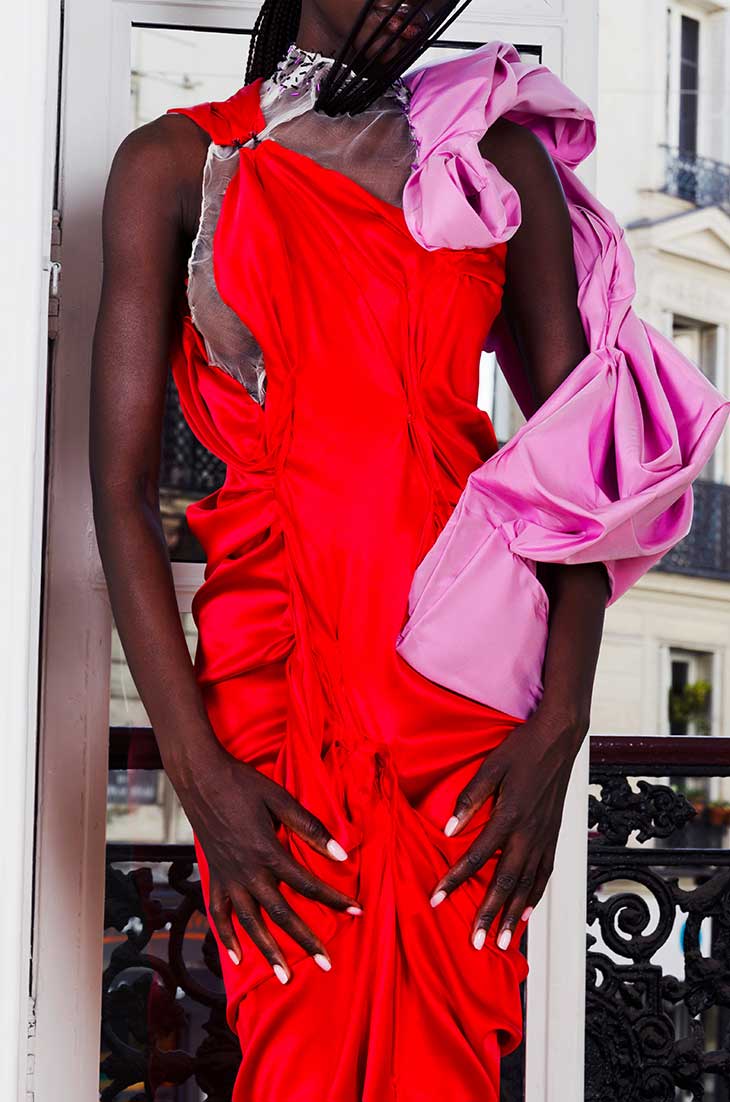
Can you share a defining moment in your career that solidified your path as a couture designer?
This is a hard question to answer, because I have known since I was young I wanted to be a couture designer and not a fashion designer. The man I idealized, Emanuel Ungaro, was not only a couturier but a very hands-on one. When I started to learn and work in the industry, it was all in the technical realm, draping, tailoring, pattern making etc. My path wasn’t very smooth, it was filled with obstacles and frustration and a call for discipline, restraint, and perseverance, something you have to have when you’re gaining technical skills. Instead of design research, beautiful illustrations, and meeting with cloth suppliers, I was learning the methodical side of making clothes. How to sew a pocket by hand, how to do an invisible hand stitch in folds and pleats, how to insert a horsehair canvas, how to properly fit, how to underline, how to catch stitch an interfacing etc.
All this technical knowledge mixed with a strong imagination ensured me that if I ever started my own design house, it would have to be in couture. The only other thing that really solidified this or inspired my push even more was when I had the honor of apprenticing in the haute couture atelier of the great master Ralph Rucci back in the late 2000’s. There was no American designer doing what he did, and even the French admitted his techniques were so different to anything they had seen.
His passion and expertise for the couture craft was something I will never forget. The world he had created for himself and his craft was so inspirational to me during that time. Even today, when I think about how you should work in this industry, the standards one should have for themselves and their craft or the discipline one must adhere to, he always comes to mind.
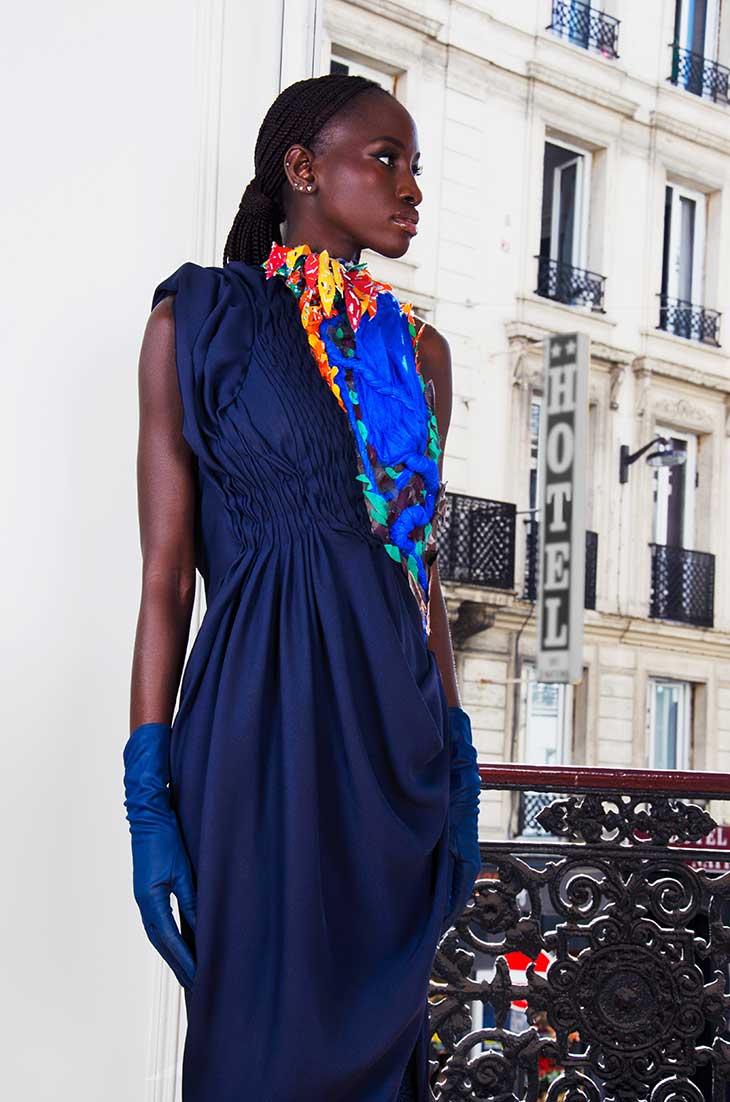
“Anyone who knows me personally, knows I have 5 great loves-Art, Couture fashion, history, music, and metaphysics. I said art first because it’s the pinnacle of my love. As a couturier, I consider myself more of an art/artisan designer than a fashion designer. Art plays an important part in all of my creations, it’s the key source of my inspiration.”
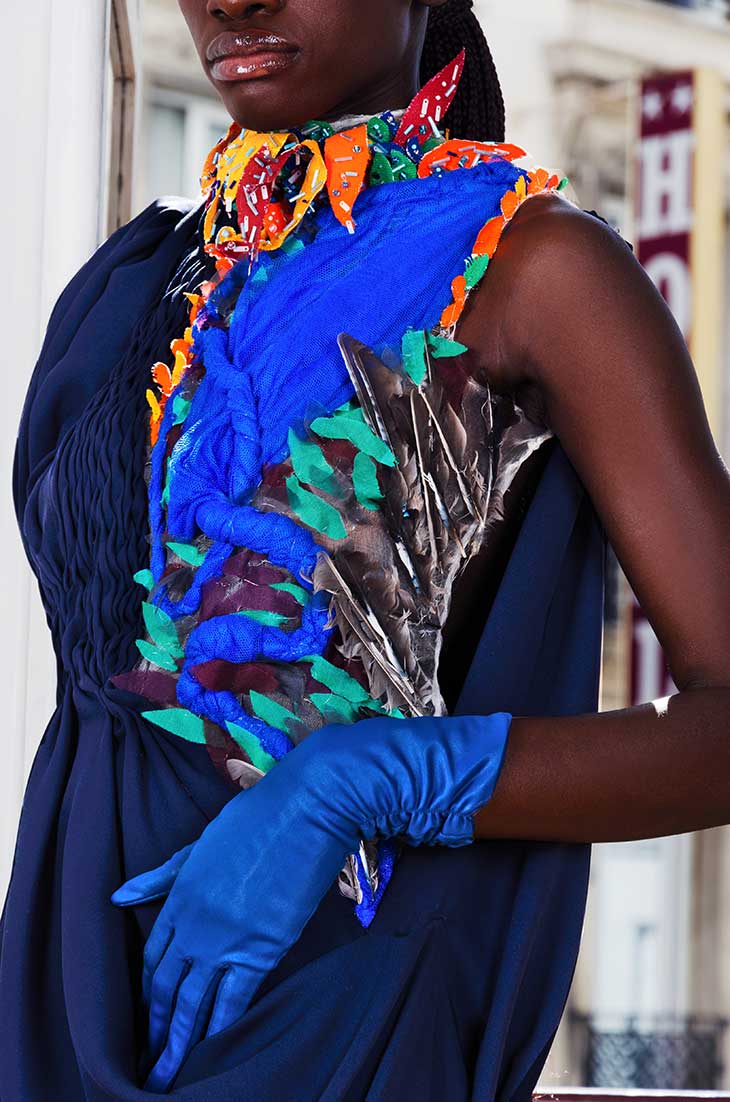
What inspired the fusion of Kandinsky’s abstract visuals with the organic motifs of African wildlife in the designs for your FW24 Collection?
I’ve always been a big fan of Kandinsky, especially his mixing and matching of color and his general theory of color. I wanted to do something in relation to his work for a while, but I wanted to take an angle that would be different from just looking at his paintings and focusing only on color. I leaned towards his synesthesia, but wanted to go deeper into his life and find something most people wouldn’t have known about or be familiar with.
While researching his life, I learned about his time in North Africa with his fiancé and fellow painter Gabriele Münter. This struck a chord with me as my imagination did the rest. I envisioned him traveling around the plains of Africa, exploring the wildlife, being inspired by the colors, shapes, and forms.
I combined this jungle theme with his color theory as well as some references to his synesthesia (which you can see from the copper foil sculptures which have a certain rhythm to them as the model walks) to develop the overall style of the collection.
Aside from Kandinsky, who are some of the artists that have influenced your work?
Anyone who knows me personally, knows I have 5 great loves-Art, Couture fashion, history, music, and metaphysics, hint the name of some of my collections (Rohini Shaman, The book of Dzyan). I said art first because it’s the pinnacle of my love. As a couturier, I consider myself more of an art/artisan designer than a fashion designer. Art plays an important part in all of my creations, it’s the key source of my inspiration.
If you’re talking about draping, then it’s the barFoque sculptures of Gian Lorenzo Bernini & Pietro Bracci or the Greek sculptures of Phidias of Athens. There are many modern & contemporary sculptors whose work I love as well, such as John Chamberlain, Fujikasa Satoko, Richard Sweeney, and Christopher Wool. All of them have been inspirational to my work from a draping aspect or general design sense.
In the world of painting, the stream of inspiration is boundless. Everyone from Chagall, Delaunay, and Masson to O’Keeffe, Frankenthaler, and Derain. The inspiration is truly endless, especially when it comes to color theory.
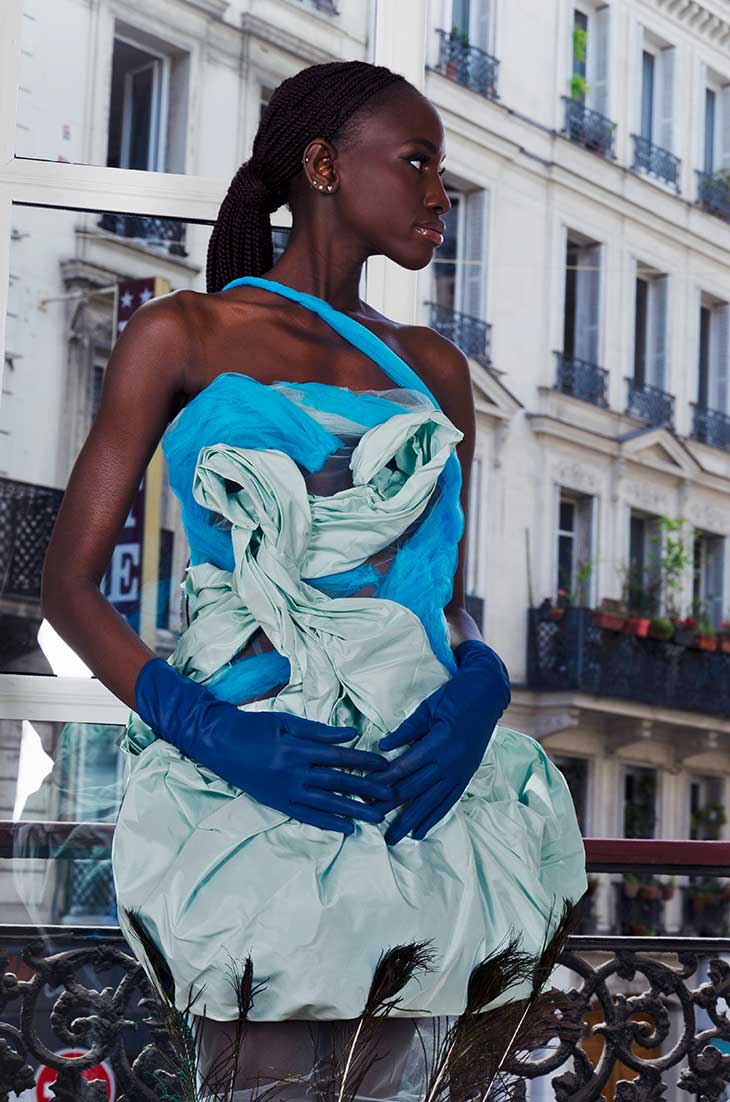
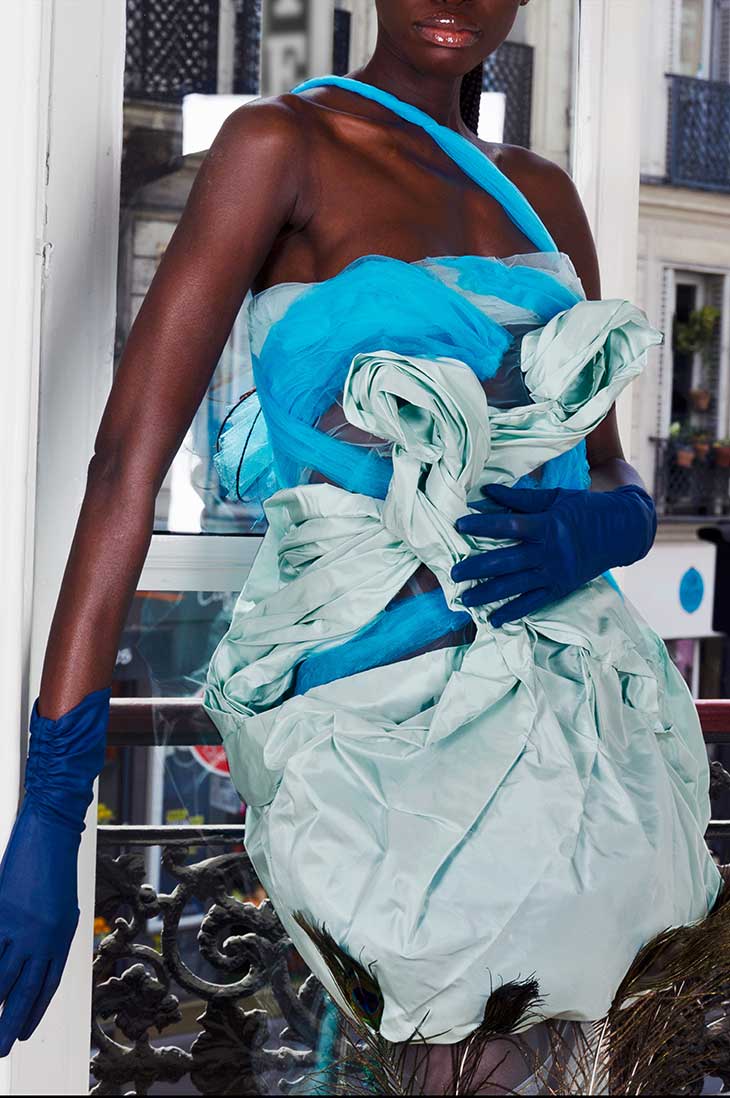
Draping plays a central role in your design philosophy, much like the legendary Madeleine Vionnet. What makes draping such a powerful medium for you as a designer?
When I was young and still in the infant stages of learning my craft and honing my skills as a couturier, I was mentored as a creator to draw and sketch my ideas and to work from there.
However, I learned early on that this didn’t suit me, which is why I gravitated towards the technical side of making clothes in a search for a clearer path to express myself, because what I found in sketching is a lack of freedom and a sort of imprisonment of my imagination. Even with bespoke pattern making (a highly skilled technique), something I have used and still use today, I find it to lack a certain depth of vision and tactile. I compare the three techniques to the difference between exploring a country, exploring the world, and exploring outer space.
With draping, you’re exploring outer space, especially with the extreme improvised form of draping which I do or a sort of aleatory. This is when you have only an idea in mind but no pattern or initial toile (prototype), and you work with the real couture fabric. In this way, you’re kind of like an astronaut walking in outer space, which can always be dangerous, but the possibilities of what you may see are endless and only limited to the hands, intuition, and imagination of the creator, something that isn’t possible with the other techniques. If I was sketching, my mind wouldn’t see beyond a certain point as I wouldn’t be close enough to the finished construction of the garment. If I was cutting a pattern, I might get closer to the final construction of my idea, but once again, my mind would still be stuck in a certain box as the limitations would still be there. The ability to see beyond a flat 2D pattern and to visualize complex shapes and intricate designs, like how 3 meters of silk organza could fold into a shoulder flower that turns into a sleeve, how a sculpted baroque pleated drape in silk gazar could cocoon around the body, and how 3 meters of silk tulle can be completely wrapped around the body with no opening or visible seams but still understand how the wearer can get in/out wouldn’t be possible without draping.
Draping is the only technique that allows me to truly explore the unknown while using my 3 best assets as a couturier; my hands, my intuition, and my imagination.
How do you keep pushing the boundaries of draping to keep your work fresh and innovative?
Through research and discovery of new materials, especially those not normally used in the couture or the making of clothes in general. I think about Monsieur Balenciaga when the Swiss textile manufacturer, Abraham first showed him a sample of silk gazar, the ideas and shapes that must have run through his mind. This is the beauty of cloth/material for a couturier, it sweeps you with creativity and grows seeds of ideas into your imagination. I’ve found this sensation with so many new materials, everything from sculpting armature material like Aluminum mesh, construction and piping material like copper and bronze foil, to recycled plastic, and now fiberglass mesh (something I’m using in this upcoming couture collection for SS25). Being able to create new types of sculptural shapes from these materials allows me to explore my vision and creativity in a broader way.
Beyond this point, I would say the act of draping in itself allows me to stay fresh and innovative in my work. There’s an Indian saying that there are 1000 ways to drape a Saree, and the essence of that statement in itself shows the boundless potential for draping. Only with draping, a technique as old as our ancient ancestors, can you find new ways to reinvent and recreate the dress silhouette. It’s an endless and limitless technique for those skilled enough or initiated enough to tap into its full potential. This is why many of the great masters who came out of Paris during the early to mid 20th century used this technique themselves or as the mainline of creation in their ateliers.
How does your expertise as a couture draper influence your use of color and texture in your designs?
Unlike tailoring, which mostly deals with lines and seams, black becomes such a great color to work with because it not only slims the body, but reduces the visibility of the seam line. When you’re draping, especially couture draping, the work has so much to do with folds, pleats, twisting, cowling, gathering etc. that if you work mostly in a black palette it would take away from the beauty of the drape. I think the style of drape more than anything determines the color, similar to how the texture or hand of the cloth determines the drape (I can’t create floating folds with a soft silk chiffon).
If I’m draping a floral shape in a crisp silk organza, I like to use pastels or bold and bright colors to really highlight the flower reference. Or If I’m draping a sculpted baroque style dress with floating folds, I prefer to work in either a white/ ivory silk gazar or taffeta and a gold/bronze heavy silk like duchess satin to capture the beauty of the heavy folds and reference baroque sculptures like Bernini’s. Everything works in tandem. The cloth determines the drape, and the style of drape I choose to make will determine my color selection. The main rule I have in choosing a cloth is no prints. I only work in solids in order to better show the folds and pleats in the drape. Then, from there, I can enhance the design with artistic elements and couture embellishments.
Beyond this, I think the clients themselves play an important role. The Angelo Fair woman is a bridge between the past and the future. She’s not a hardened classicist or overtly futurist. She’s someone who appreciates the quality and elegance of old world craftsmanship while at the same time having an eye for what’s new. She doesn’t shy away from color as she understands the richness of its beauty and its nuova approach in my designs.
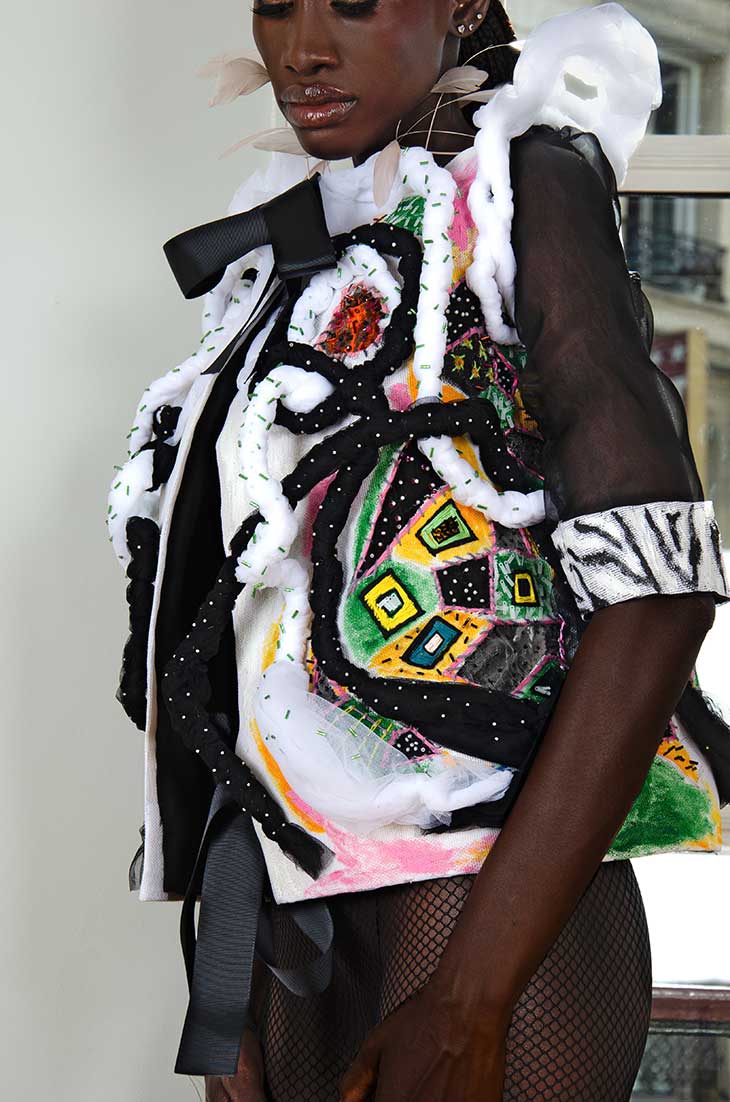
The incorporation of hand-braided tulle and sculptural shapes in your Kandinsky Jungle collection is quite impressive. Could you explain the process behind crafting these elements?
In relation to hand braiding, I was inspired by fingerloop braiders from the 13th century and Kute-uchi from Japanese culture. In my research for couture techniques & embellishments I came across these amazing artisans who produced a truly beautiful handicraft not unlike couture embroidery.
In my work, I had to individually hand twist up to 15 meters of tulle in between the tips of my fingers while removing all the tension, until they were so stiff and tight they stood up on their own like a statue. As I twisted and manipulated the cloth, I had to whip stitch invisible thread around the twist every 3 to 5 millimeters while at the same time releasing the cloth at certain points to leave excess tulle for me to drape with. It’s a time-consuming process, but one of those techniques you can only do in haute couture.
For the sculptural shapes, a lot of these were conjured up through the art of draping and a good understanding of the physics of cloth. If you take the bronze silk duchess satin dress with the hand braided and hand beaded pink tulle embellishment around the chest and neck, this dress was engineered through the use of a calico underskirt. The underskirt fabric had to be strong enough to take the weight and drape of the silk duchess satin, while light enough to also be sewn to the upper body of the silk organza. This calico was able to act as a weight control for the dress by ensuring the heavy skirt didn’t have to sew directly to the lightweight transparent organza, which reduces pulling and tension on the sheer cloth.
You can also look at the multi-coloured silk chiffon dress with the black silk organza balloon back drape and coque feathers. This was created via an understructure of paper nylon tulle which is stiff enough to not only support but enhance the organza drape while light enough to not strain or add tension to the soft chiffon cloth (too much weight and the dress shifts backwards). It’s all cloth physics, something that a well-versed couturier and draper knows.
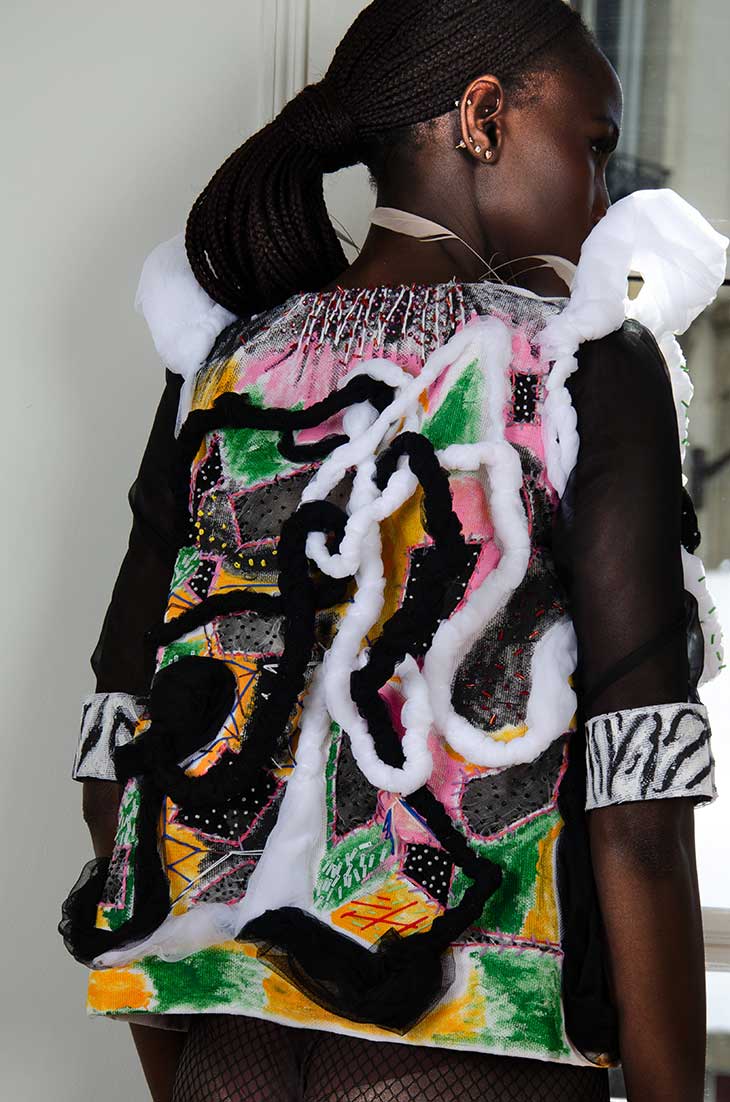
What is your strategy for harmonizing traditional couture craftsmanship with innovative design in a rapidly evolving industry?
For me, the focus is on material, especially raw materials in the area of couture embellishments. For example, this past season, I had a green and blue silk organza dress that had sculpting clay as seed buds with plastic and hair spikes from a brush coming out of it to create a kind of puffer fish or porcupine feel for the jungle theme.
For my SS24 couture collection entitled Book of Dzyan (junk art couture), I used internal computer screen glass that was broken apart, melted, forged together and hand painted as a hem embellishment on a silk chiffon and organza dress. The whole thing looked like falling stained-glass. On another dress, I took recycled polymer from water bottles and merged this with the outer screen from a computer monitor which was then hand painted and covered in resin. All of these new techniques still require some use of the same couture sewing methods I was originally trained in.
A lot of my push for innovation, especially in the futuristic sense, is in the realm of embellishments. I find most of my inspiration for this comes from the world of art. Following modern and contemporary artists like Alberto Burri and his avant-garde work with materials, Michelangelo Pistoletto’s glass and mirror work and his overall experimental approach, or the ingenious paintings and sculptures of Frank Stella. Like artists who find their ability to innovate and push boundaries through new or everyday objects, I work with the same adherence, looking outside the box for new techniques and materials.
Through these artists and artisans, not only do I find a common understanding of design, but learn new techniques not yet explored in the world of haute couture.
“Draping is the only technique that allows me to truly explore the unknown while using my 3 best assets as a couturier; my hands, my intuition, and my imagination.”
As one of the few designers who creates couture dresses from start to finish, how do you think this hands-on approach impacts the final result of your collections?
It impacts it in every way. For instance, I can’t produce a collection of 50 couture pieces each season because my approach is so hands-on, and due to a basic lack of time and my need to maintain such a high quality of workmanship (every garment is 100% hand made by design), this would be impossible. So what ends up happening each season is that I only produce a small selected number of curated pieces.
Another example would be that every garment you see, every style that’s created is based on me and what I can physically do. If I discover a new embroidery technique or embellishment technique, or a new type of art medium I want to try, I have to master the technique and incorporate it into the style myself. There is no outsourcing of my ideas. The collections are limited or enhanced by my creative and physical abilities. This was important for me when I created the house as I wanted the work to be as close as possible to the artist’s hands.
When I think about the world of art and the craft of artisans I know, the work you see comes directly from their 2 hands. I don’t think Degas looked upon a room full of ballerinas and thought, now let me get someone to go draw this or Szukalski picked out his bronze and then found someone to sculpt his ideas. These men were considered geniuses not only because of their creativity, but their actual physical skills of dexterity. We used to have this in fashion. The timeless ingenuity in the work you see of Madame Gres dresses came from her hours of pleating. The revolutionary silhouettes that came from Cristobal Balenciaga‘s house were through his mastery of drapery and the sculpted ball gowns Charles James produced, which were literal works of art, were created directly by him.
Nowadays, when someone says this designer or that designer is a great tailor, they are either talking about their atelier or their manufacturer, as most of the designers are not tailors and wouldn’t know what to do with a sloping shoulder, caved chest, let alone a needle and thread. True artisan designers like Alaia, Ungaro, Sorbier, Galante, Rucci, are disappearing. I take pride in my approach, one I find to be an homage to true masters of the past while keeping an avant but modern sensibility. So, in that way, I feel this hands-on approach makes me more inline with artists or artisans than our modern form of a designer.
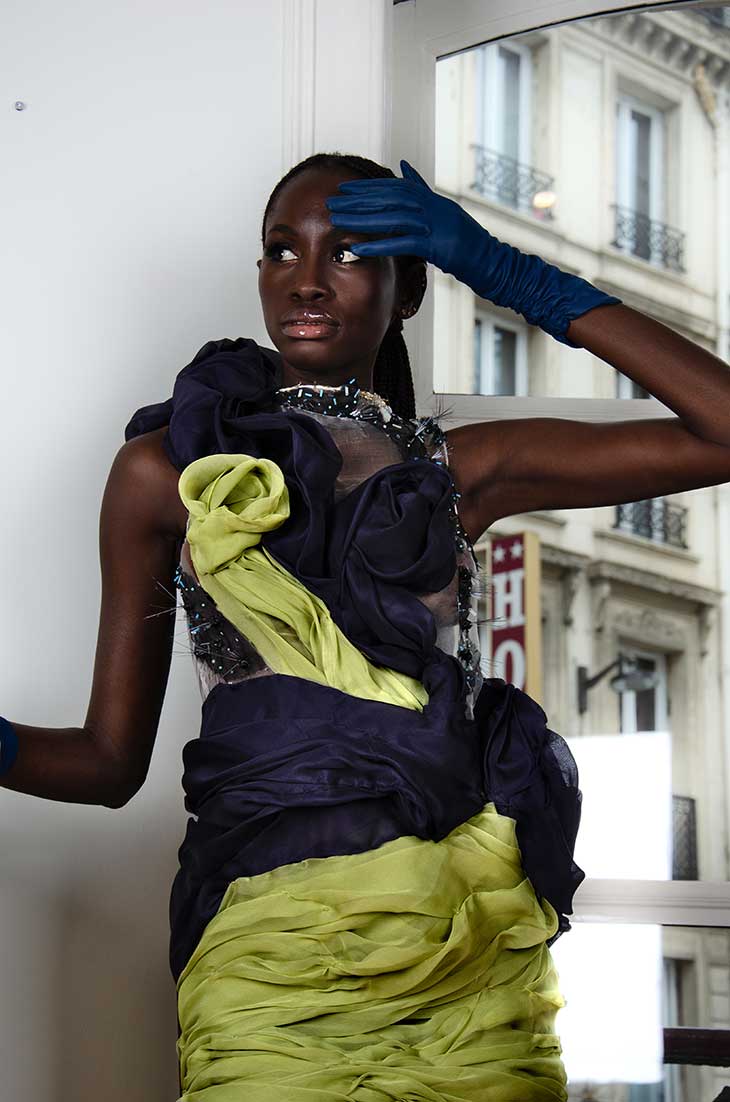
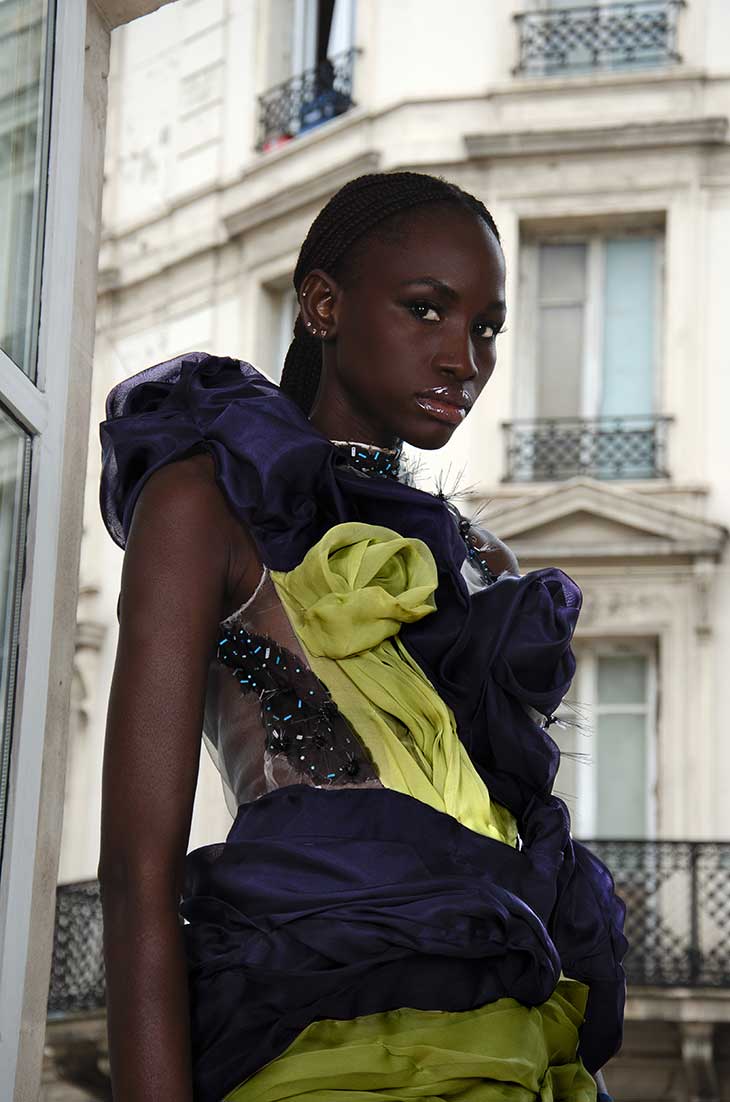
Among all your work, is there a collection or design that you hold close to your heart, and can you share why it stands out for you?
The Father Time jacket from my AW22 couture collection, Rohini Shaman. This jacket was kind of an awakening for me as a couturier, because it showed me I could really make anything I imagined. The jacket incorporated all of my skills. One side was a black wool sleeveless tailored jacket with all the key components such as calico underlining, horsehair front canvas and chest pad with hand padded lapels, handmade buttonholes and a skeleton base. The other side featured an extravagant baroque-style white silk gazar drape that served as both a sleeve and extended dramatically off the body, flowing about a meter behind the jacket. The whole thing looked very Bernini. In front of the jacket was a plaster sculpture of a face I made, with one side covered in hand-painted silk organza. The sculpture was placed in a holder that was draped onto the front of the jacket, all from the same piece of silk gazar that also formed the sleeve. Surrounding the holder were Baume et Mercier watch faces, emphasizing the Father Time theme. The jacket was held in place by laces extending from the sculpture and tying up the back. It was a true tour de force.
View the collection in the Gallery below:
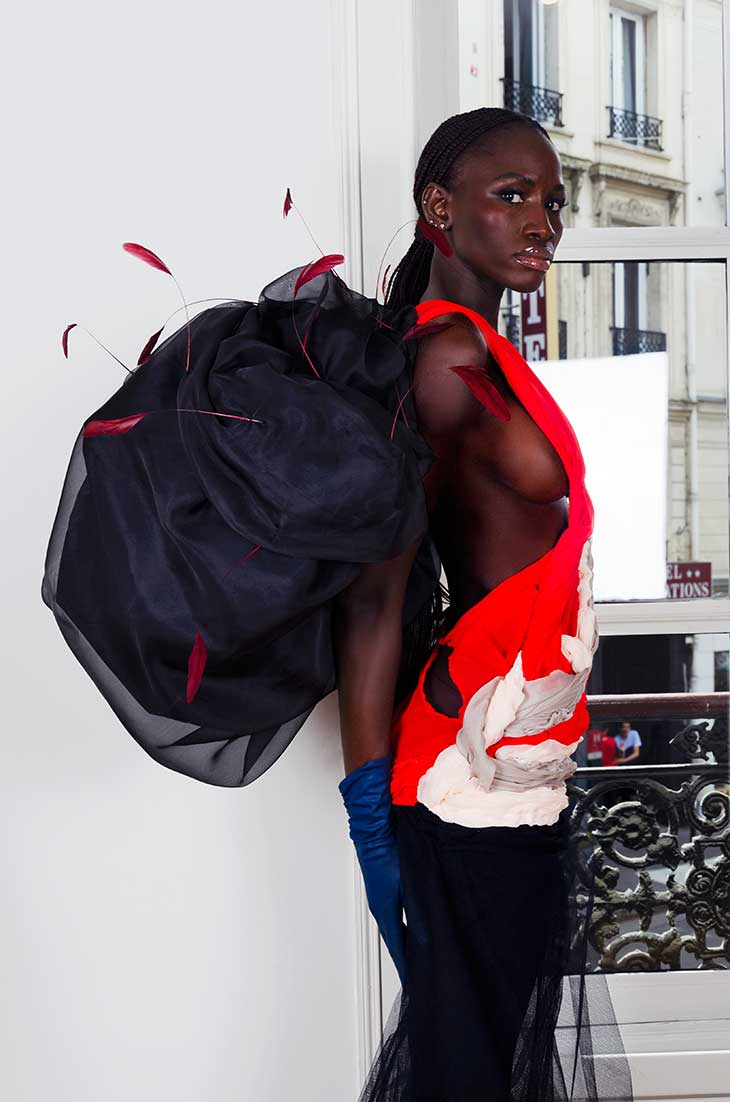
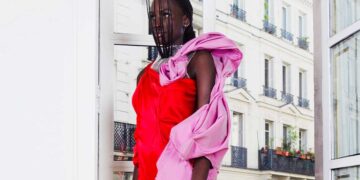














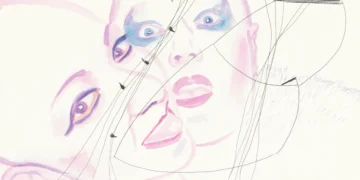
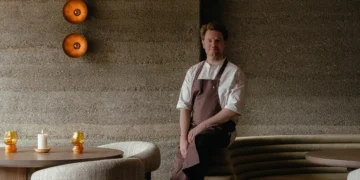
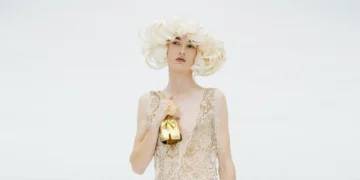


Wow, really beautiful.